Recently, we approached some of the folks at Stonemaier Games about the creation of a Megagame in the Scythe Universe (also known as the 1920+ Art Universe created by Jakub Rozalski). We were thrilled with their informal encouragement and quickly became worried that the output wouldn’t live up to expectations. Well, I’m happy to report that Sickle received a grand premier at Con of the North last weekend in Minneapolis! IT WAS AMAZING!! Robots and Land Reform! Coups and Conspiracies! All with one of the best News AV-interfaces I’ve ever witnessed (pics below).
| Player Feedback Statements | Average Player Rating (out of 5) |
| I had fun! | 4.74 |
| The rules were easy enough to understand | 3.68 |
| I would recommend this to a friend | 4.47 |
| Based on this experience, I am more likely to attend a similar event in the future | 4.47 |
Here’s what happened and what we’re going to do better next time. Additionally, for those interested, I’ve prepared a downloadable preview that has the player handbook and some other game materials as a preview at the end of the post.
CORRECTION: The appropriate spelling of the Scythe Universe nation for which the Republic of Poland is loosely based off of is “Polania”, not “Polonia”. The designers regret this error and all the bears it may have offended.
The Action
The Slide and Fall of the Rusviet Union
I was lead control (head moderator) and ended up aiding the Rusviet Union Control as the Rusviet Union was a disaster throughout the game. The Rusviet Union of the 1920+ Universe is an odd beast with no historical counterpart, as the world-building implies that there’s a communist Russian Government headed by the (still-alive) Tsar. I ended up modelling the Rusviet Union after the Dual Powers period in Russia, and divided players roughly into conservative Tsarists, liberal Democrats, and socialist/communist Radicals.
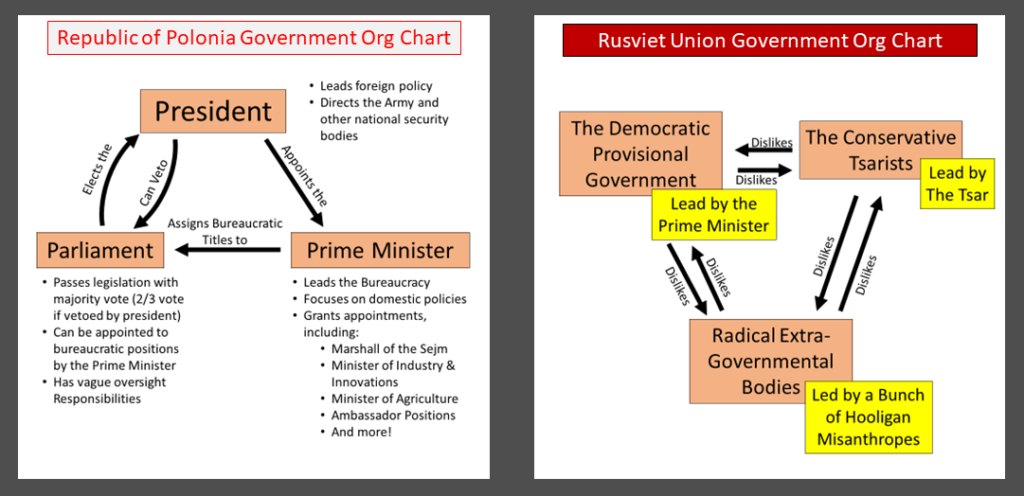
During their intro briefing, I attempted to stress that none of the Rusviet factions (currently) had the ability to seize power due to the aftermath of the Great War. Unfortunately, that’s a hard idea to stress in such a freeform game with a bunch of first-time players. At the first possible opportunity, the Radicals staged a failed coup and were promptly suppressed. I think part of the reason the coup failed was that some players were first-time mega-gamers or LARPers who didn’t realize how much they were acting against their player brief and long-term self-interest by not supporting the coup. Instead of sticking around and be suppressed, I gave the brutalized Radicals new player roles as the Kaiser and Imperial Chancellor of the Saxony Empire (Germany).
The celebrating Tsarist and democratic forces declared the re-founding of the Byzantine Empire and briefly reinstated serfdom. Then, immediately dissolved serfdom. This would be a reoccurring phenomenon due to the Prime Minister’s sign-first-and-fix-whatever-disaster-he-just-signed-off-on-later attitude. Later on, the temporary use of gulags almost caused multiple players to independently revolt.
Separately, the ironically named ‘Leninator’, a 100-ft. tall mech which struck a resemblance to the mech in our flyer, had been commissioned. Designed by the player role-playing as the great engineer, Konstantin Chelpan, the mech appeared to have one arm that was a giant scythe and one arm that looked like a machine gun, although many claimed that the machine gun was for shooting corn into tall silos. The Leninator’s intended purpose was never clearly defined but led to much arguing over how to use it. I remember hearing “It’s just a piece of farm equipment!” shouted multiple times to the both fellow Rusviets and paranoid Saxon and Polonians.
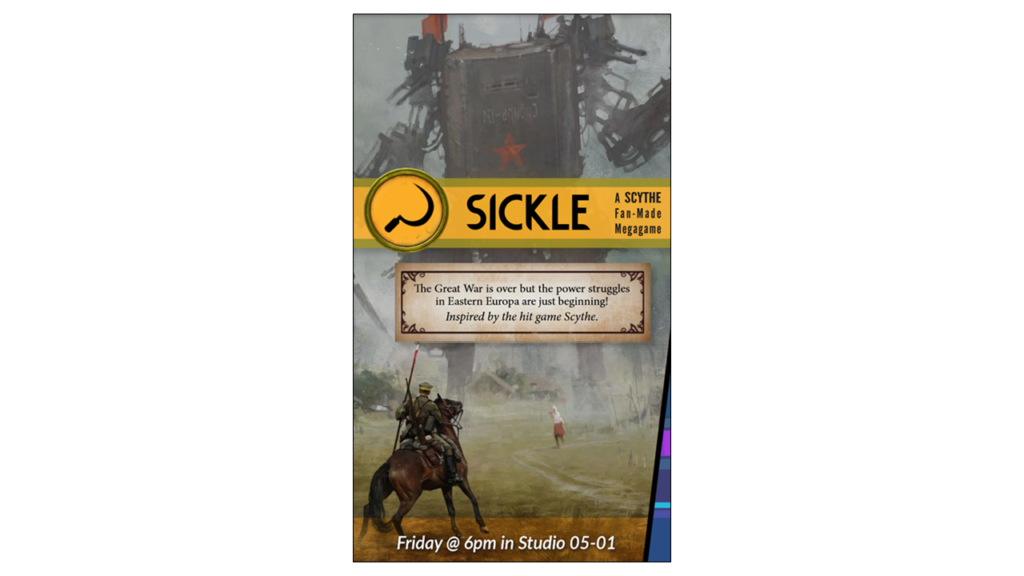
Self-imploding through the implementation of draconian Tsarist policies and failing to meet their resource goals, several players discussed revolt. Chelpan was half-kidnapped, half-defected to the Saxony Empire, taking his schematics for gun-blades, rocket drills, and the wood be-gone with him, all of which were supported with enthusiasm by Saxony government and produced on mass. Chelpan’s crowning achievement was the ‘Stalingreator’, a rival mech to the Leninator whose purpose was anything but agricultural. This set the stage for what was to be the ultimate climax of the megagame.
The Saxony Empire was a smaller team made up largely of the players who had failed to topple the Rusviet Union government early in the game. Because of their small team size and similar player motivations, there was little internal disagreement, leading to a laser-like focusing on spiting the Rusviet Union. In addition to poaching Chelpan (whom later they built a multitude of statues for in celebration of his contributions to the military), the Saxony Empire started on a crusade to modernize the military. At one point, a player rotated the schematics for ‘Rocket Drills’, originally built for mining purposes, 180 degrees and proclaimed, “I THINK I GOT SOMETHING!”.
During the Saxony military buildup, the Rusviet Union was playing into the surprisingly devious hands of the neighboring Republic of Polonia. Unlike the R.U., Polonia had been led by a calm player with moderate in-game political philosophies. Relatively civil discussions had decided functional policies and a sense of comradery against the big, nasty Rusviet Union Byzantine Empire had developed. Many of the Polonian players wished to bring the Rusviets to their knees, but the Rusviets were already sawing their own legs off. Capitalizing on the desire for the Rusviets to détente with the Polonians, they extracted a number of concessions – the big one being that if the Rusviet Union and Saxony Empire were to go to war, it would not be on Polonian soil (scout’s honor). Later, the Polonians received the same promise to not wage war on Polonian soil from the Saxons as well.
While unfortunately, I did not see a lot of the Polonian side of the game, they clearly had a lot of fun. Some highlights include the arguments over land redistribution and the schematics of Marie Curie, which included a small radioactive bomb resembling a fidget-spinner and poke ball stuck together, and a nuclear power plant, which ended up being a Mountain Dew label taped to the schematic. Tangentially, I was worried that the craziness of giant mechs and other zany technologies would detract from the serious discussions around land reform, taxes, government, etc., but was elated with the deftness by which players would switch from talking about taxes to talking about giant robot duels.
The game, only three hours in, had now enjoyed multiple story arcs and appeared to be climaxing with the Saxony Empire and the Rusviet Union Byzantine Empire gearing up for war. The game ended with the Saxony military firing a barrage of drill-rocket rockets at the Rusviet forces holed up in the dilapidated Factory (South of Polonia). This was two be coupled with a naval invasion of Northern Russia via the Baltic Sea – a war plan eerily similar to the Rusviet Union’s.

Given that the Rusviet Union was in constant disarray and the huge investment of Saxony into its military resources, we generally agreed that the Saxons would have won the immediate military conflict at the least. This was exemplified by the deployment of the Stalinagreator to the war front, supposedly to take-down the Leninator. Unfortunately, wires had been crossed and the Leninator had been mistakenly deployed to help with the harvest. Or maybe the Leninator had been a piece of farm equipment all along. Overall, the true winner of the scenario was Polonia, who had successfully gotten their rival nations and former oppressors to kill each other outside of Polonia.
The Design
National Security Decision Making (NSDM) with some additional spice
The design was based on the National Security Decision Making System (NSDM) format that uses over-sized name tags to display to the world what every knows about the individual or faction the player represents while detailing the player’s private objectives and motivations on the back.
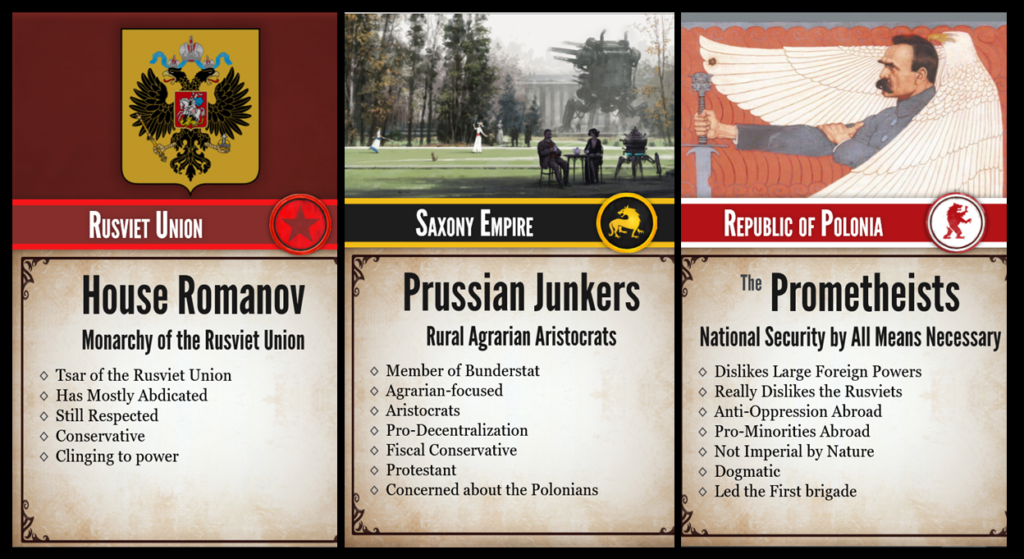
The second defining feature of the NSDM format is the freeform system of how players do things. In order to do actions or undertake initiatives, they simply need to fill out what they want to do on a card and then have the appropriate factions also sign off on it. If you want to mobilize the military, a general’s signature is required. To raise tariffs, get the trade deputy’s signature. This is a simple system that turns what is often GM-player interactions into player-player interactions. Below are some initiatives from the game.
Accompanying the name tags and the freeform player-signature system is a control-moderated News feed projected onto a wall for everyone to see. With the help of Jed Limke of Prairie Fire Games, we were able to create our own amazing News feed program that looked great and really streamlined the News system.
I love the NSDM system and encourage anyone attending large tabletop conventions (Origins, Gen Con, and Dragon Con especially) to seek them out. The NSDM crew is a group of retired foreign policy experts and military officials who enjoy running NSDM games to simulate geopolitical negotiations. They’re nothing short of excellent and emulating this system was intimidating, specifically due to the need for extremely skilled moderators who can filter information, keep players engaged, and challenge players when necessary. I’m lucky enough to know some of the best (special shout out to J.S. Majer from Chicago, who came up for the event).
I added two more systems on top of the NSDM base. First is a relatively simple system of national resource management. Represented by poker chips, nations as a whole would collect wood, iron, oil, food, and luxuries (resources of the Scythe boardgame + luxuries) in order to meet their national resource targets. If the nation failed to meet their target, moderator would inform them of a national tragedy that has befallen their nation.
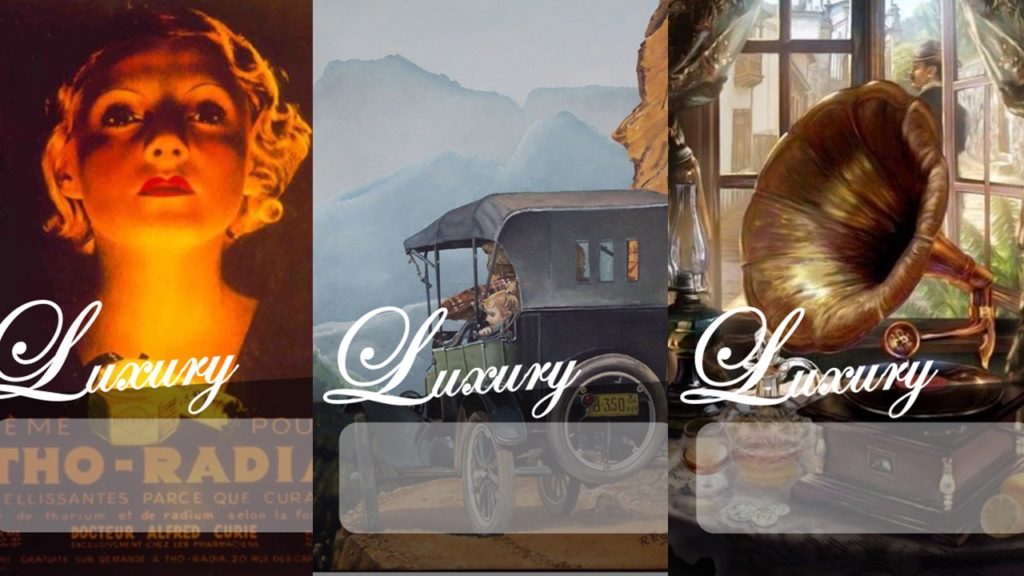
Second, I introduced “great individual” player roles into the game. These players were given grided legal pads, pencils, pens, and rulers. They could draft inventions that could then affect the game. To increase player cooperation, I made sure to stress that the ‘schematics’ drawn were just schematics and that outside resources and cooperation were required in order to build the inventions. Below are some of the Schematics of one of the two great individuals we had in the game, sadly the designs of Marie Curie were lost to history.
Feedback
Player Feedback & Game Stats
Players rated their experience through gauging their agreement in a 1 to 5 scale, with 5 being “strongly agree” with the statement.
| Statement | Player Average |
| I had fun! | 4.74 |
| The rules were easy enough to understand | 3.68 |
| I would recommend this to a friend | 4.47 |
| Based on this experience, I am more likely to attend a similar event in the future | 4.47 |
Importantly, I explicitly asked if the difference in gameplay between the Scythe boardgame and this event affected their individual experience at all, as I was worried that we were inadvertently tricking people into arguing about land reform when they instead wanted to move mech miniatures around a hex board. I am happy to report that the vast majority of the players said the gameplay differences did not affect their overall experience.
Last, players had the chance to provide whatever comments or suggestions they desired to provide. Most the comments simply reiterated how much they enjoyed the game but there were some reoccurring comments suggesting:
- Better on-boarding of players who showed up late and missed the introduction/rules explanation. Some of the players mistakenly did not get printed rules as well.
- Some slight restructuring of the game to increase the clarity of the systems
- Some slight restructuring of the various factions to increase the clarity of internal faction dynamics.
- Start with three smaller nations instead of two larger nations.
- Better illumination of the Universe during the intro brief and the game (projected map of Europa for example). I discovered that a large portion of the players had actually not played Scythe before and thus had not heard of the Factory. This, accompanied by the moderators being too busy to reward initiatives involving the Factory, met the Factory was not leveraged to its full effect during the game – although it did become the prime target Saxony’s aerial mining drill-rockets!
These were great suggestions and they’ll definitely be implemented going forward.
Moving Forward
The Future is Bright!
The game will be simplified and improved moving forward. Overall, however, I am surprised about how little I’m planning on changing for the next iterations. Some specific focuses:
- Restructuring the Rusviet Union faction to make them a little less internally factional. Perhaps focusing on the factions of the 1905 revolution instead of the dual powers period. Or perhaps really leaning into the communist angle but keeping the Tsar in their in a type of ‘gilded cage’.
- Making a more structured experience involving interactions with the Factory.
- Definitely pre-preparing a process for on-boarding people and making 100% sure that everyone gets a printout of the rules.
- Some reference cards for moderators and “prime minister” players involving the bureaucratic positions of their nation.
- We started the game with two crises (famine and the ‘Turkish Flu’). These crises were forgotten extremely quickly by the moderators. Future pre-generated crises will have a greater structure and moderators will provide more positive feedback for players attempting to solve these disasters.
- Working on a better introduction/rules briefing.
- Change size of the title badge so you can where a title badge and a regular badge without them covering each other up.
- Change feedback forms from a 1-5 scale to 1-10 scale to get a finer resolution of opinions and be better able to compare games to each other.
Wrap Up
Overall, overwhelming success! Thanks to all the players and control for making this possible!
Special thanks again to Stonemaier Games for encouraging fan-made products and events like this one!
Our next project will be a Dwarf-themed megagame, Deephaven, by Minnesota Megagames‘ in-house published game designer, Trenton Greyoak! We’ll be debuting it in the Minneapolis-St. Paul area this spring before putting it on again at Gen Con with Sickle: A Fan-Made Megagame, and Draft Night 3077 in coordination with the larger Megagame Coalition. Follow Minnesota Megagames on Facebook to keep up to date on our upcoming projects!
Us at Minnesota Megagames are also especially excited for the upcoming Power to the People, being run in association with Chicago Megagames, a political Megagame that has more to do with abstracted negotiation (I’ll vote for this if you back-stab them, without letting them know I was involved) than arguing over policy specifics.
Downloadable files
Here’s a taste of the game!
Here are links to the Player Rules Briefing (both word doc & pdf). Note, the page order of the pdf only aligns if you print out the pages and fold them together like a booklet.
Here are links to the the Rusviet Union individual Nation Briefing (both word doc & pdf). Note, the page order of the pdf only aligns if you print out the pages and fold them together like a booklet.
Last but definitely not least, here is a pdf of the badge fronts! This would give you a good idea of what types of factions and player roles people had.

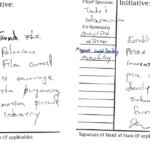


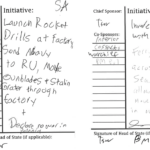






Pingback: Entente: A Political Waltz in 19/14 Time - MegaGame Coalition